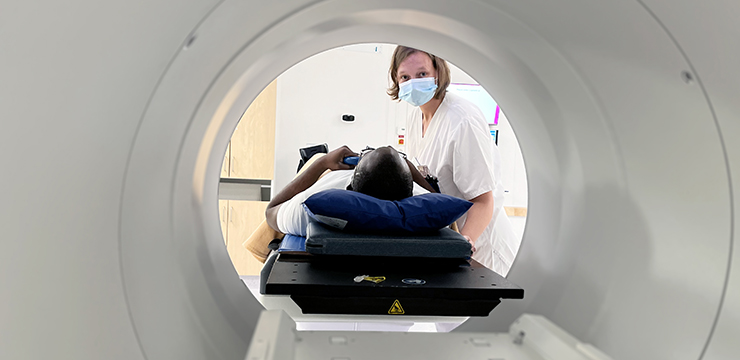New radiation technology adapts in real time to the tumor's movements during treatment

Previously, radiation technology has been used to monitor movements in the body. In turn the radiation is switched off if it falls outside the acceptable limit. With the new tech, however, the radiation field instead follows the movement of the body and does not need to be switched off. The technology, called Synchrony, was used for the first time during radiation treatment at Skåne University Hospital in early October. Thus far the addition has been successful.
“So far, we have used the new technology for radiotherapy on one of our patients who has prostate cancer. We are continuously evaluating the technology while working to gradually use it more on patients who have tumors located in a complicated spot. The plan is to also use the technology in the treatment of other forms of cancer in the future”, says Per Munck Af Rosenschöld, medical physicist and manager at the Radiotherapy Physics Unit at Skåne University Hospital.
Tumors can move during radiation therapy
Each year, approximately 4,500 patients are treated with radiation therapy at Skåne University Hospital in Lund. Radiation treatment is usually divided into several sessions and patients who are to be treated with radiation undergo computed tomography or magnetic resonance imaging, in accordance with their treatment. At each radiation treatment session, X-ray imaging is carried out to aim the beam at the targeted area of the body. To compensate for the fact that the tumor may move during the treatment, extra margins are added, which means that the radiation field is made larger.
X-ray images in real time
The new technology makes it possible to take X-rays while the radiation treatment is in progress, calculate the position of the tumor and adjust the radiation field to the new position without turning off the radiation. The patient's breathing can also be followed to further obtain a real-time model of how the tumor moves.
According to Petronella Lannerheim, oncology nurse at Skåne University Hospital, this means that certain types of tumors that move during treatment can be irradiated with higher precision than before, thus avoiding that surrounding tissue receives unnecessary radiation during treatment.
“We are not there yet, but the technology is being tested, in the long run it means we could reduce the risk of complications that can otherwise occur after radiation treatment, such as intestinal problems. Ultimately, this technology can contribute to improved quality of life for the patient”, Petronella Lannerheim says.
Paradigm shift in radiation technology
Because the radiation has higher precision, the technique is useful primarily on tumors that move while treatment is ongoing, as well as in radiation-sensitive tissue, in the vicinity of the tumor. Examples of this are certain types of prostate cancer, less extensive lung cancer and occasional metastases in the lung.
“The technology involves a paradigm shift where we take a step from traditional radiation technology with static treatments, to adaptable treatments that are shaped in real time according to the position of the tumor during ongoing treatment. Region Skåne has allocated research funds to further push the development of real-time radiotherapy and to further investigate the precision and possibilities of the technology”, says André Änghede Haraldsson, medical physicist at the Radiotherapy Physics Unit.

